The Super Antioxidant Supplement Market is estimated to be valued at USD 588.3 million in 2025 and is projected to reach USD 995.5 million by 2035, registering a compound annual growth rate (CAGR) of 5.3% over the forecast period.
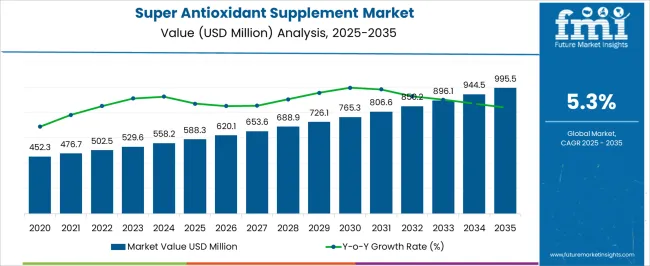
| Metric | Value |
|---|---|
| Super Antioxidant Supplement Market Estimated Value in (2025 E) | USD 588.3 million |
| Super Antioxidant Supplement Market Forecast Value in (2035 F) | USD 995.5 million |
| Forecast CAGR (2025 to 2035) | 5.3% |
The super antioxidant supplement market is experiencing accelerated growth, driven by rising consumer awareness of oxidative stress, immunity, and healthy aging. Demand for supplements that deliver high bioavailability and targeted functional benefits has expanded across retail and online channels.
The market is supported by continuous innovation in ingredient formulations, with a strong focus on natural and clinically validated compounds. Heightened health consciousness, accelerated by lifestyle-related disorders and global wellness trends, has reinforced adoption.
The current scenario reflects rising demand from both younger demographics seeking preventive care and older populations focused on managing age-related conditions. Future prospects are favorable as personalized nutrition, e-commerce distribution, and regulatory support for functional foods further stimulate demand, positioning antioxidant supplements as a high-potential category within the global nutraceutical landscape.
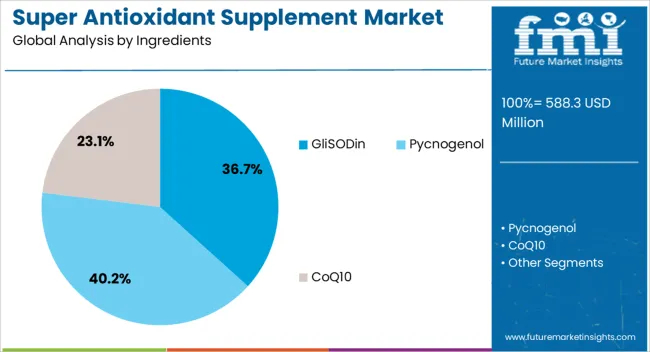
The GliSODin segment leads the ingredients category, holding approximately 36.7% share of the super antioxidant supplement market. This dominance stems from its role as a patented form of superoxide dismutase (SOD), which provides enhanced bioavailability compared to traditional antioxidants.
The segment has gained traction due to its scientifically supported efficacy in reducing oxidative stress and supporting overall wellness. Manufacturers have emphasized its clinical validation, which has contributed to consumer trust and adoption in premium supplement ranges.
With increasing demand for high-potency, natural, and branded ingredients, the GliSODin segment is expected to retain its strong positioning in the market.
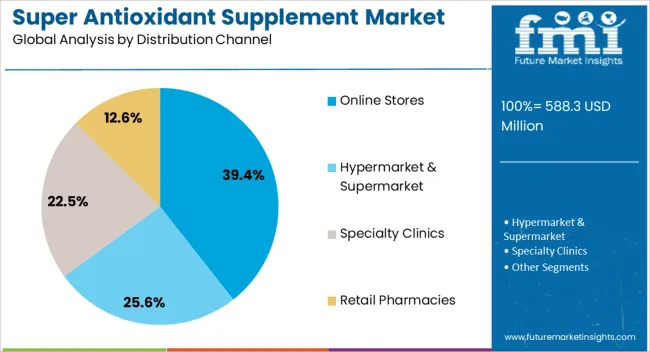
The immune booster segment dominates the application category, accounting for approximately 42.5% share. This segment has expanded rapidly in response to heightened consumer focus on immunity, particularly in the aftermath of global health crises.
Super antioxidant supplements positioned as immune boosters benefit from their association with enhanced cellular defense, reduced inflammation, and improved recovery. The segment has also been reinforced by broad application across diverse demographics, from preventive wellness in younger populations to immunity maintenance in aging consumers.
With continued emphasis on preventive health and the rising integration of antioxidants into multi-functional formulations, the immune booster segment is expected to sustain its leadership.
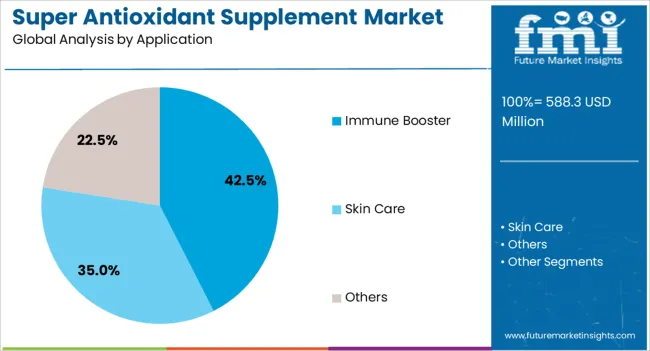
The online stores segment leads the distribution channel category, representing approximately 39.4% share of the super antioxidant supplement market. E-commerce has transformed supplement accessibility, offering convenience, broader product availability, and personalized purchase experiences.
Online platforms have provided opportunities for both established brands and niche players to reach global consumers, supported by digital marketing strategies and direct-to-consumer models. Rising smartphone penetration and secure digital payment infrastructure have further accelerated adoption.
With continued expansion of online retail ecosystems and increasing consumer comfort with digital purchases, the online stores segment is expected to remain a dominant sales channel for antioxidant supplements.
The market value for super antioxidant supplements was around USD 452.3 million in 2020 and reached USD 588.3 million in 2025.
The sale of super antioxidant supplements expanded at a CAGR of 5.2% from 2020 to 2025, owing to the increasing prevalence of health issues because of antioxidant deficiencies.
The increasing rate of cigarette smoking is damaging the body and leading to immunity deficiency. For instance, as per the statement by the Centers for Disease Control and Prevention, people who are consistently smokers are more likely to develop cardiac disorders, lung cancer, and stroke. Due to the fact of increasing cancer prevalence, the consumption of supplements containing beta-carotene and vitamins is highly in demand.
Additionally, the use of immunity-boosting supplements during the COVID-19 pandemic has set new heights for antioxidant supplements. Supplements containing anti-inflammatory and antiviral properties were highly in demand as they helped boost immunity in the patients. Thus, owing to the aforementioned factors, the global super antioxidant supplements market is expected to evolve at a CAGR of 5.4% during the forecast period.
The demand for super antioxidant supplements among the population is rising. Government agencies and industry players are also developing fresh approaches to boost market expansion. Additionally, the rise in investments in new research and other initiatives is subsequently helping the market to grow.
The rising geriatric population across the globe is creating a solid customer base for multivitamin supplements. This can be a lucrative opportunity for market players to expand their products and generate revenue. Furthermore, increasing awareness about super antioxidant supplements in developing and underdeveloped countries is creating opportunities for market players.
Dietary supplements can have high economic value, making them vulnerable to fraud. Similar to other forms of fraud, the sale of counterfeit supplements has the potential to compromise the integrity of items that are made with high standards. Customers who buy tainted or mislabelled nutritional supplements through unconventional supply chains put their health at risk without even realizing it. This may hamper the brand value for certain manufacturers.
Furthermore, taking antioxidant supplements in excessive doses may occasionally be associated with health hazards. High amounts of beta-carotene supplements may make smokers more susceptible to lung cancer. Prostate cancer and other types of stroke risk may rise with heavy vitamin E supplementation. Cumulatively, these factors propose a negative effect on the developmental growth of the super antioxidant supplements market.
| Countries | Market Insights |
|---|---|
| The United States | 22.5% |
| India | 7.1% |
| China | 10.5% |
| Germany | 4.2% |
| The United Kingdom | 3.3% |
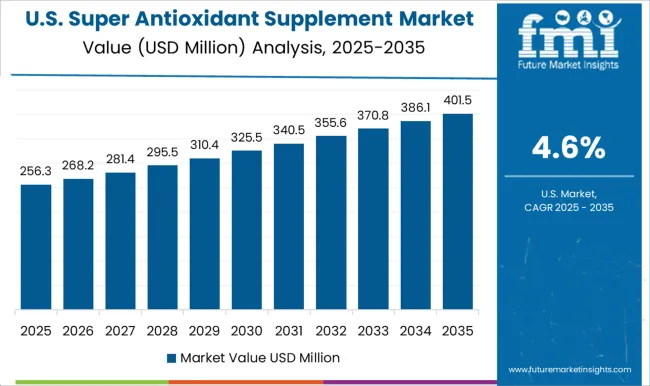
The United States dominates the North American region with a total market share of about 83.6% in 2025 and is expected to show the same growth throughout the forecast period.
The key factor driving the United States super antioxidant supplements market is the growing popularity of antioxidant supplements. As people in the United States are aware of the benefits of antioxidant supplements, the demand for these supplements is increasing. The increasing government initiatives to raise awareness of novel super antioxidant supplements among the populace and the development of incorporating antioxidants in medication to provide immunity and wellness are propelling the market.
Furthermore, a growing interest in a healthy lifestyle and an increasing rate of chronic diseases in the United States is further budding the market. Antioxidant supplements may help to prevent chronic diseases such as cardiovascular diseases and macular degeneration, as they help neutralize free radicals.
The super antioxidant supplement market in the United Kingdom recorded a market share of nearly 21.5% in 2025. The leading factor driving the market growth is the rising concerns of skin issues among the population.
The increasing concerns about outer appearance, especially among women, are increasing the demand for skin care supplements, as they provide hydration, reduce wrinkles, and improve the structure of the skin. Furthermore, the purchasing capacity of the population and increasing consumption of supplements is anticipated to boost market growth.
China is set to exhibit a growth rate of nearly 7.0% in the super antioxidant supplements market from 2025 to 2035. The rising awareness about super antioxidant supplements due to the increasing infectious diseases over the past few years is propelling the market growth in China. Besides this, the growing expenditure on health-promoting products and development in clean-label beverages further enhance market growth.
The increasing disposable incomes of the population and increasing customer base for healthy drinks in China are expected to drive the market.
| Ingredient | GliSODin |
|---|---|
| CAGR | 5.7% |
GliSODin is expected to show growth of 5.7% in the projected period, with a market share of 59.3% in 2025. GliSODin is highly used in skincare supplements as it promotes improvement in the skin’s structure and provides hydration to the skin. Thus, the rising demand for skin care products among people has increased the demand for antioxidant supplements.
The immune booster segment is propelling the market of super antioxidant supplements by 41.5% of the market share in 2025 and is expected to expand with a CAGR of 5.9% by 2035. The growing prevalence of infectious diseases and other common disorders owing to insufficiency of immunity.
| Application | mmune Booster |
|---|---|
| CAGR | 5.9% |
Super antioxidant supplements are highly recommended for boosting immunity. Thus, the demand for super antioxidant supplements is increasing by driving the market growth.
| Distribution Channel | Online Store |
|---|---|
| CAGR | 6.5% |
The online store segment held a significant market share of around 39.9% in 2025, with an expected growth rate of 6.5% by 2035. The availability of novel products on different online sites, and increasing accessibility of the products across different regions is expanding the market for super antioxidant supplements and is assumed to expand in the coming future.
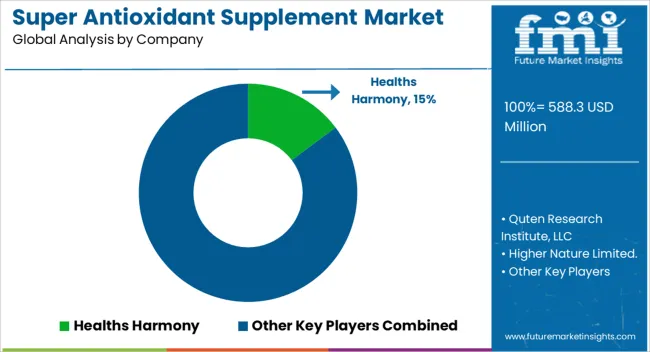
In the super antioxidant supplements market, market players are employing various strategies to boost their sales and generate revenue. These companies are actively engaging in activities such as marketing campaigns and launching new and innovative products to meet consumer demand and expand their market presence. Market players are adopting these strategies in the super antioxidant supplements market to enhance their competitiveness and capture a larger share of the market.
Recent Development
| Attribute | Details |
|---|---|
| Forecast Period | 2025 to 2035 |
| Historical Data Available for | 2020 to 2025 |
| Market Analysis | USD million for Value |
| Key Regions Covered | North America; Latin America; Europe; South Asia; East Asia; Oceania; and Middle East & Africa |
| Key Countries Covered | United States, Canada, Brazil, Mexico, Argentina, United Kingdom, Germany, Italy, Russia, Spain, France, BENELUX, Nordic Countries, India, Thailand, Indonesia, Malaysia, Japan, China, South Korea, Australia, New Zealand, Turkey, GCC Countries, and South Africa |
| Key Market Segments Covered | Ingredients, Application, Distribution Channel, and Region |
| Key Companies Profiled | Healths Harmony; Quten Research Institute, LLC; Higher Nature Limited.; Inlife Pharma Pvt. Ltd.; NOW Foods; Bluebonnet Nutrition Corporation; Puritan's Pride, Inc.; Vegepower; Solgar Inc.; Sigmaceutical; Livestamin Healthcare LLP; Nu-Gen Nutrition, Inc.; Inlife Pharma Pvt. Ltd. |
| Pricing | Available upon Request |
The global super antioxidant supplement market is estimated to be valued at USD 588.3 million in 2025.
The market size for the super antioxidant supplement market is projected to reach USD 995.5 million by 2035.
The super antioxidant supplement market is expected to grow at a 5.3% CAGR between 2025 and 2035.
The key product types in super antioxidant supplement market are glisodin, pycnogenol and coq10.
In terms of application, immune booster segment to command 42.5% share in the super antioxidant supplement market in 2025.






Full Research Suite comprises of:
Market outlook & trends analysis
Interviews & case studies
Strategic recommendations
Vendor profiles & capabilities analysis
5-year forecasts
8 regions and 60+ country-level data splits
Market segment data splits
12 months of continuous data updates
DELIVERED AS:
PDF EXCEL ONLINE
Superconducting Detector Market Size and Share Forecast Outlook 2025 to 2035
Super Calendered Glassine Paper Market Size and Share Forecast Outlook 2025 to 2035
Super Absorbent Polymer Market Size and Share Forecast Outlook 2025 to 2035
Superalloys Market Size and Share Forecast Outlook 2025 to 2035
Superheater Tubes Market Size and Share Forecast Outlook 2025 to 2035
Super Apps Market Size and Share Forecast Outlook 2025 to 2035
Superconducting Quantum Chip Market Size and Share Forecast Outlook 2025 to 2035
Superconducting Materials Market Size and Share Forecast Outlook 2025 to 2035
Superficial Radiation Therapy System Market Size and Share Forecast Outlook 2025 to 2035
The Super Generics Market Is Segmented by Drug Type, Therapeutic Area, Route of Administration and Distribution Channel from 2025 To 2035
Super Generics Industry Analysis in Europe Report - Trends & Innovations 2025 to 2035
Superficial Punctate Keratitis Treatment Market Insights – Demand and Growth Forecast 2025 to 2035
Super Resolution Microscope Market Insights - Size, Share & Forecast 2025 to 2035
Superfood Powders Market Analysis - Size, Share & Forecast 2025 to 2035
Superconducting Magnets Market Growth – Trends & Forecast 2025 to 2035
Supercapacitors Market Report - Trends & Industry Outlook through 2034
Super Barrier Coated Film Market Trends & Forecast 2024-2034
Superfood Market Trends – Growth & Industry Forecast 2024 to 2034
Super Junction MOSFET Market
Superconducting Wire Market

Thank you!
You will receive an email from our Business Development Manager. Please be sure to check your SPAM/JUNK folder too.
Chat With
MaRIA